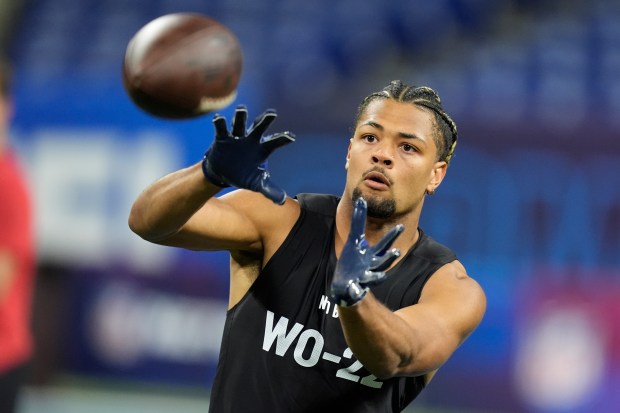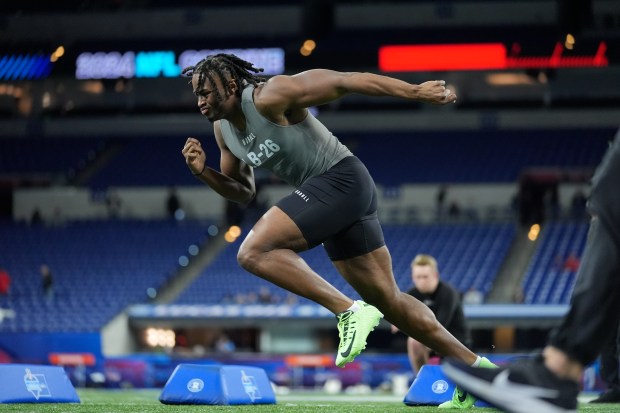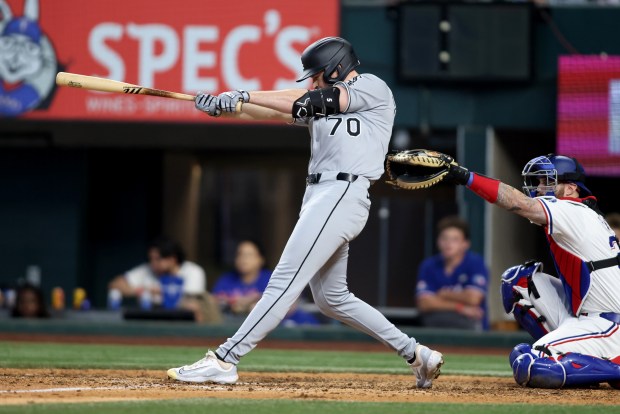Ryan Poles’ collection of draft picks has dwindled, but intrigue surrounding what the Chicago Bears general manager will do with the ninth selection only increased after he added six-time Pro Bowl wide receiver Keenan Allen.
The Bears agreed Thursday night to trade their fourth-round pick to the Los Angeles Chargers for Allen, a deal that will be official after he passes a physical, likely Saturday.
Paired with DJ Moore, Allen gives the Bears two excellent receivers, their best combination since Alshon Jeffery and Brandon Marshall teamed together from 2012 to 2014. With tight end Gerald Everett and running back D’Andre Swift added to a mix that includes tight end Cole Kmet — coming off a career-best season with 73 receptions for 719 yards — the Bears have seriously upgraded the skill-position talent for what is expected to be a new quarterback, likely USC’s Caleb Williams.
“We’re extremely excited to add Keenan to our team,” Poles said in a news release. “His body of work speaks for itself and we look forward to him elevating our offense.”
A second wide receiver was a major need entering the offseason, and this is the best collection of skill talent the Bears have had since 2013, when tight end Martellus Bennett and running back Matt Forte were also on a roster that included Jeffery, Marshall and quarterback Jay Cutler. All of a sudden, the Bears have the firepower needed to compete in the NFC North with two other young rosters: the Detroit Lions and Green Bay Packers.
Poles can add Williams — or another quarterback — with the No. 1 pick, and it’s easy to dream about the potential of the Bears offense, which has ranked in the top half of the league in scoring only twice in the last 11 seasons (second in 2013, ninth in 2018).
How it all meshes will be fascinating to track as the Bears position themselves to begin making more splashy headlines with their regular-season performance than their offseason action. Who emerges as the undisputed leader of the offense will be pivotal to any immediate success. Those are stories that will unfold in the months to follow.
First, let’s dive into what the Bears are getting with Allen and how his arrival affects moves to come — understanding that roster building is a concurrent project as teams prepare for the now while simultaneously plotting for the future.
- Allen was leading the NFL with 108 receptions through Week 13 last season before a heel injury forced him to miss the final four games. He wound up sixth in catches and 11th in receiving yards (1,243), remaining a high-volume producer in his 11th season. He also missed seven games in 2022 with a hamstring issue and hasn’t played a full season since 2019.
- Allen turns 32 in April and is entering the final year of a contract that calls for an $18.1 million base salary plus a $5 million roster bonus due Sunday. Veterans often are motivated to have their best seasons in contract years, so the Bears can expect Allen to be ready to roll.
Big money remains available for aging wide receivers too. Mike Evans is a different type of player and a year younger than Allen, but he just signed a two-year, $41 million contract with $35 million guaranteed to stay with the Tampa Bay Buccaneers.
The age component gave some front-office personnel from other teams reason for concern regarding the trade, but there’s no doubt it gives the Bears added flexibility in the draft, as we’ll explore in a bit.
- Had the Chargers released Allen — they reportedly tried to reduce his salary as they did with edge rushers Khalil Mack and Joey Bosa — it’s unlikely he would have gotten a deal approaching $23 million for one season.
- On the field, Allen’s skill as a route tactician has not been affected by age or wear and tear. He’s still as good as it gets in terms of getting open and being a first-down machine. That skill set should mesh well with Moore, who is more explosive. Allen caught 100 passes during Justin Herbert’s 2020 rookie season with the Chargers.
- What the future holds for Allen is worth exploring. Does Poles imagine him as a contributor for a few seasons, or is he comfortable with Allen being a one-year rental who potentially could net the Bears a 2026 compensatory draft pick if he exits via free agency next March? In that scenario, the Bears could come close to getting their draft-pick investment back down the road.
It does seem unlikely the Bears would be thinking about an extension for a wide receiver going into Year 12 at age 32, but who knows? It doesn’t mean he’s not a great asset now for a rookie quarterback and the $23.1 million cap hit isn’t problematic for a team with ample space.
How the Allen acquisition triggers dominoes yet to fall is where it gets captivating. One can make an excellent argument for any of four possibilities — one of which would lead to even more choices.
After the trade, the Bears have four draft picks: Nos. 1 and 9 in Round 1, No. 75 in Round 3 and No. 124 in Round 4 (from the Philadelphia Eagles). Keep in mind Poles can recoup a pick by trading quarterback Justin Fields, but it appears that after Poles said at the scouting combine that his goal was to do right by Fields, there might not be strong trade interest. Also, it’s not considered a deep draft overall, so a lack of Day 3 picks shouldn’t be overly concerning.
Four scenarios for the No. 9 pick
1. Stay put and draft one of the top three wide receivers.

If there’s a run on quarterbacks after the Bears presumably choose one at No. 1, there’s a decent chance Washington’s Rome Odunze or LSU’s Malik Nabers would remain available at No. 9. Getting one of them would set up the Bears for the future with Moore turning 27 in April.
Poles would be choosing a player at a position a year before he needs him, but the top three receivers are supremely talented — some believe Odunze and Nabers are near Ohio State’s Marvin Harrison Jr. in ability and projection — and his young quarterback would be set up for seasons to come. The Bears could develop a talent at a position for which they’ve had to turn to the trade and free-agent markets too often in the last decade-plus.
2. Stay put and draft an offensive tackle.
Just as the receiver crop is talented and deep, there is an excellent group to consider at this position. Notre Dame’s Joe Alt, Oregon State’s Taliese Fuaga, Penn State’s Olu Fashanu, Washington’s Troy Fautanu and Alabama’s J.C. Latham are highly regarded.
If the Bears don’t deem Braxton Jones, who has 28 starts at left tackle, as a building block for the future, they could replace him with a draft pick or slide Darnell Wright to the left side and insert a rookie at right tackle. They potentially could get the second or third offensive lineman off the board at No. 9.
Poles and assistant GM Ian Cunningham are former linemen. Poles knows firsthand the pitfalls — there haven’t been many — that Patrick Mahomes has had in Kansas City when he has been behind a leaky line. Cunningham was in Philadelphia as the Eagles built a stout line with premium talent and depth.
The Bears have worked on the depth part already in free agency, trading for center/guard Ryan Bates and signing center Coleman Shelton, swing tackle Matt Pryor and tackle/guard Jake Curhan. Having bookend tackles on rookie contracts has an appeal.
3. Stay put and draft an edge rusher.

The collection of quarterbacks, wide receivers and offensive tackles makes it possible Poles would have his choice of the first defensive player to come off the board at No. 9. A defensive end or situational pass rusher to play opposite Montez Sweat remains a need. Alabama’s Dallas Turner, Florida State’s Jared Verse and UCLA’s Laiatu Latu are considered the best options.
Poles solidified the back end of the defense by signing cornerback Jaylon Johnson to a four-year extension and adding free safety Kevin Byard in free agency. The front still needs to improve for the Bears defense to become elite. If Poles and coach Matt Eberflus want to focus on the interior, Texas’ Byron Murphy would be an interesting addition.
4. Trade down from No. 9, add draft capital and address one of the aforementioned positions.
It’s easy to discuss the possibility and make a case for doing it. It would require a team motivated to move up to the ninth pick with an offer that meets the Bears’ needs. Poles got a fourth-round pick from the Eagles last year to move down from No. 9 to No. 10.
The ninth pick might not be a hot spot for quarterback activity if there’s an early run on the position, and the Bears would need a plan in place to use the selection if they’re motivated to deal down but can’t get a solid return or would be required to fall lower in the first round than they want to go.
If the Bears really like a wide receiver in the position’s second tier — after the top three — or are comfortable with multiple offensive linemen and/or edge defenders, a trade down makes sense. They can get a player they covet and add picks and be better positioned to fill multiple spots. It’s probably a best-case scenario, but only if their destination keeps them within striking distance for a player they would have been happy with at No. 9.
There’s something to be said for staying at No. 9, though, and choosing the best player on the board. The Bears have some momentum. They’re coming off a 7-10 season and planning to be significantly better in 2024. They don’t plan to pick anywhere near No. 1 — or No. 9, for that matter — in 2025. It’s a shot at a potentially elite player with the team hoping it’s not in the top 10 again for years to come.
It’s not like Poles should feel desperate to have more draft picks either. He has plenty of cap space remaining to maneuver as he chooses, and the Bears had a 10-man draft class in 2023 with nine of the players still around.
They had one of the youngest rosters in the league and aren’t in danger of being plagued by depreciating older players across the depth chart without the infusion of a typically sized draft class. Poles can have a smaller class and still feel like the roster has a lot of young players with room to develop.
Whichever quarterback the Bears wind up with — and make no mistake, they are almost certainly headed in that direction — will enter a situation with far greater surrounding talent than the typical No. 1 pick at the position encounters.
Allen is a high-profile player and Poles isn’t done with major moves. The quarterback will be the biggest piece of the offseason, and what happens subsequently in the draft will dominate conversation with more than five weeks to go until April 25.




